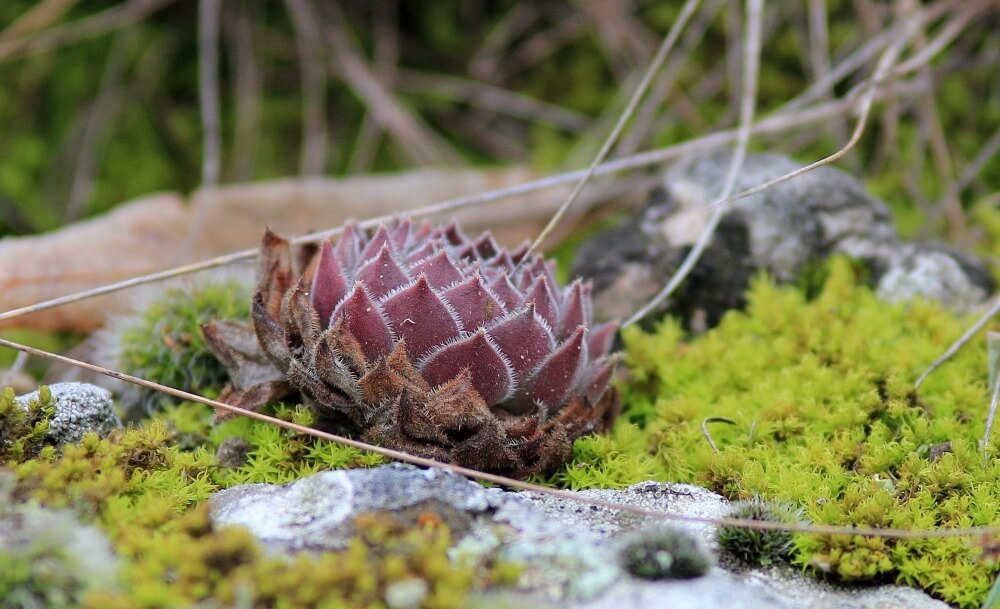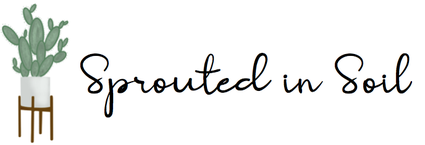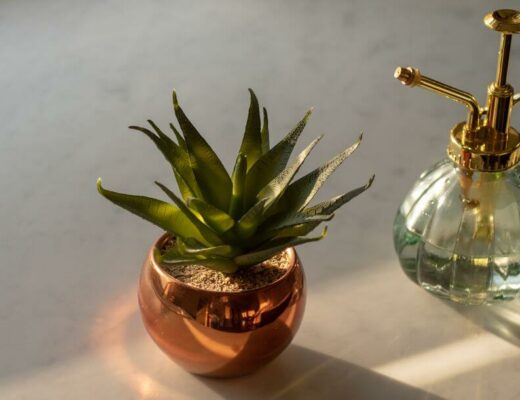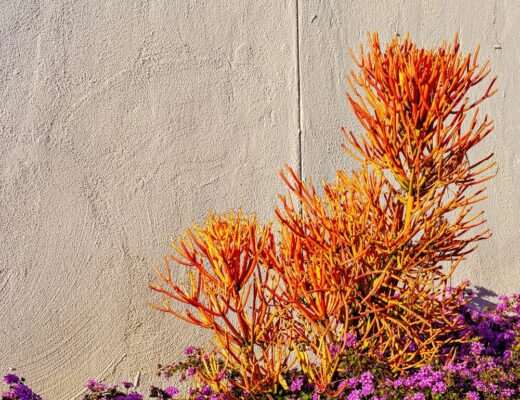Purple succulents range from the deepest of amethyst to the palest of lilac and add a beautiful splash of color to your room. These succulents are some of my favorite and I’m always on the lookout for more to add to my collection.
This list will not only cover some of the best purple succulents but how to care for them as well!
1. Echeveria ‘Perle von Nurnberg’
One of the most famous and widely collected succulents, ‘Perle von Nurnberg’ has a dusty purple glow that spreads to the margins of its leaves. The curved leaves expand outward from the center in a rosette pattern that can grow up to 5 inches tall and 6 inches wide.

To keep this purple succulent growing in a tight rosette, ensure your ‘Perle von Nurnberg’ receives bright, direct morning to early afternoon sunlight. This type of light will “stress” your plant causing the leaves to maintain their frosted purple gradient.
To water, fully soak well draining soil and allow to completely dry between waterings.
‘Perle von Nurnberg’ is easy to propagate by leaves and cuttings, so you can share this beautiful plant to an endless number of friends and family.
- Mature Size: 5” tall, 6” wide
- Hardiness Zone: Zone 10
2. Graptoveria ‘Debbie’
Graptoveria ‘Debbie’ is a beautiful cross between a Graptopetalum and Echeveria hybrid with pinkish purple colored leaves that, when stressed by bright light, fade into a peach-like orange at the edges.

Perfect to plant with other succulents or in it’s own pot, the rosettes can grow up to 8 inches tall and 8 inches wide.
Adding to this already colorful purple succulent, powdery pink/purple blooms flower at the ends of long stalks. If planted outside, these purple flowers attract hummingbirds.
Completely drench the soil when watering and ensure the soil dries completely before the next watering.
Graptoveria ‘Debbie’ creates numerous offsets that can be easily propagated.
- Mature Size: 8” tall, 8” wide
- Hardiness: Zone 10
3. Graptopetalum pentandrum subsp. superbum
Flat, frosty lilac leaves create an invitingly flat rosette shape. This purple succulent needs full, bright sunlight to maintain it’s frosty glow.

Brilliant yellow flowers with red centers will bloom in the very late winter into early spring.
Plant your superbum in well draining soil whether it is placed in a pot on a sunny window or outside if you live in a warm climate.
Propagate using healthy leaves or small growing offsets.
- Mature Size: 12” tall, 6” wide
- Hardiness: Zones 9-11
4. Echeveria ‘Cubic Frost’
This stunning, unique purple succulent has powdery curved, cubed leaves, thanks to the farina (protective cuticle) that covers the surface of the leaves. Because the farina provides the plant with extra protection, this succulent does best in bright, direct sunlight and will give you a colorful show.
Like most succulents, plant your ‘Cubic Frost’ in well draining succulent soil and let the soil completely dry between waterings.
- Mature Size: 8” tall, greater than 8” wide
- Hardiness: 10
5. Lithops optica ‘Rubra’
This chubby stone-like succulent is best known commonly as a living rock. Aptly named due to its pebble-like shape, this living rock is a beautiful ruby-purple that does best with minimal (I really mean minimal) amounts of water.

Since this deep purple succulent is native to the deserts of Namibia, it will grow best when watered more during its winter growing season and less (again….VERY minimal) during its summer dormancy.
A small, delicate flower blooms from the center of the two leaves in late summer into fall.
Plant in extremely well draining soil.
New chubby club-shaped leaves, that give this dark purple succulent its pebble-like nature, grow during winter after the old leaves die off.
- Mature Size: 3” tall, 3” wide
- Hardiness: 10
6. Gymnocalycium friedrichii ‘Purple Moon Cactus’
Reminiscent of a lollipop, this purple cactus is actually formed by grafting two different plants together; the Gymnocalycium mihanovichii and Hylocereus.

An overly simplified version of grafting is this; the ribbed spherical Gymnocalycium is cut and placed on the top of a cut Hylocereus, a cylindrical or triangular branching genus of cacti. Secured together by tape or a rubber band, the grafting of roots takes roughly 3 weeks.
Similar to other cacti, the care for a ‘Purple Moon Cactus’ is simple. Plant in well draining soil and water sparingly, when the soil is completely dry.
Place this purple cactus in bright but indirect light, just slightly away from the direct rays of sunlight. Expect vibrant purple flowers to bloom from the plant’s crown.
7. Echeveria ‘Dusty Rose’
Like all Echeveria, ‘Dusty Rose’ grows to be a medium-sized rosette with spade-like leaves. Variation in colors between plants is due to the amount of exposure to direct sunlight; a light violet/pink ‘Dusty Rose’, sometimes with an icy blue center, can turn a vibrant deep purple when placed in window that receives full sun.

This beautiful purple succulent can grow up to 5 inches tall and 8 inches wide. Remember to keep in bright sunlight so the leaves don’t begin to grow apart and stretch.
When planted in well draining soil and watered modestly by drenching and letting dry completely, the ‘Dusty Rose’ succulent will readily produce new offsets at the base of the original plant.
- Mature Size: 5” tall, 8” wide
- Hardiness: Zone 10
8. Opuntia santarita ‘Santa Rita Prickly Pear’
Expect things to get a bit prickly when you add this purple hued cactus to your collection.

This prickly pear cactus grows upright and out like a shrub with flat, ovate paddle leaves covered in spines. Once mature, this cactus can grow up to 8 feet tall outdoors.
The color of the prickly pear’s pads changes with the seasons. Winter is the time of year during which you get to enjoy a rich variety of purple hues. As the days begin to lengthen and the temperatures warm towards summer, the leaves will change back to a soft glowing greenish-gray.
Yellow flowers pop during the spring that give way to edible purple fruit.
- Mature Size: 8’ tall, 10’ wide
- Hardiness: Zone 7
9. Echeveria ‘Esther’
While more subtle than other purple succulents, Echeveria ‘Esther’ is still beautifully unique. ‘Esther’ is an Echeveria that will grow in great clusters that will ultimately create a colorful “floor” of plants.
This Echeveria is special because its dainty sea green leaves are rimmed in a purple magenta. To get more vibrant margins, place your Echeveria ‘Esther’ in bright, direct sunlight.
When watering, ensure the well-draining soil is completely drenched. Allow soil to dry between waterings to avoid root rot and pests.
- Mature Size: 5” tall, 2” wide
- Hardiness Zone: 10a
10. Aeonium ‘Zwartkop’
This marvelous Aeonium is a tall branching succulent with deep purple black rosettes atop long woody stems. The center of the shiny purple leaves has a pop of lime green.

To maintain this rich purple, keep your Aeonium ‘Zwartkop’ in a place that receives six plus hours of direct sunlight a day. This succulent will reach its biggest size when grown outdoors, however it absolutely needs to be brought inside when temperatures begin to approach freezing.
Plant in well draining gritty soil. This Aeonium has normal succulent watering requirements.
- Mature Size: 36” tall, 6” wide
- Hardiness: Zones 9-12
11. Pachyphytum oviferum ‘Moonstones’
These trailing purple succulents are made up of chubby, jelly bean shaped leaves that vary in colors from coral pink to frosty purple. Easy to propagate by stem cuttings, you can create beautiful arrangements of succulents with a rainbow of colors.

Place in a sunny window so your Moonstone keeps its color.
Plant in well draining soil and water infrequently, allowing the soil to dry out completely between watering.
Pachyphytum oviferum are pet safe, so if your plant begins to trail over a pot closer and closer to the floor, don’t worry if your curious dog decides to snag a leaf.
- Mature Size: 8” tall, 4” wide
- Hardiness: Zone 10
12. Echeveria ‘Lola’
One of my all time favorite purple succulent, Echeveria ‘Lola’ colors shift from a pearlescent mint green to a frosty purple rose.

Delicate leaves form a tight rosette that create a tight center similar to that of a rose bud. To maintain this compact shape, place your ‘Lola’ in bright light.
New Echeveria ‘Lola’ are easily propagated from tiny offsets that grow at the base of the mother plant or from healthy mature leaves.
Once mature, Echeveria ‘Lola’ can grow up to 6 inches wide and up to 5 inches tall, growing taller in a pyramid shape.
- Mature Size: 5” tall, 6” wide
- Hardiness: 10
13. Echeveria ‘Black Prince’
Completely opposite of Echeveria ‘Lola’, ‘Black Prince’ boasts rich deep black purple leaves that grow out from a dark green center. Keeping with this gothic theme, Echeveria ‘Black Prince’ produces deep red flowers in the fall.

Whether planted indoors or in a garden, ensure this purple succulent receives at least 6 hours of sunlight daily to maintain its rich hue.
Like most Echeveria, plant in well draining soil. When watering, fully soak the soil and allow to dry between waterings.
Propagate using mature leaves or by replanting the baby green offsets that grow around the base of the plant.
- Mature Size: 8” tall, 8” wide
- Hardiness: Zone 10
14. Sempervivum ‘Raspberry Ice’
The cold weather loving “sister” to the Echeveria, Sempervivum can display beautiful deep colors in cooler temperatures. ‘Raspberry Ice’ is one such Sempervivum that has a primary grey color that fades into a deep burgundy.

This succulent may appear dainty with its thin leaves and velvety texture, however they can survive temperatures down to -20°F. Afraid to plant this outside in a chilly Michigan winter? Don’t worry, ‘Raspberry Ice’ will love resting under the snow.
New plants, or chicks, grow by branching off from the main mother plant.
- Mature Size: 3” tall, 6” wide
- Hardiness: Zone 5
15. Kalanchoe humilis ‘Desert Surprise’
‘Desert Surprise’ has large flat green leaves with tiger-like purple stripes that grow into a large bush. Not only are these plants beautiful inside, they are great in an outdoor flower bed because they attract hummingbirds.

Make sure your ‘Desert Surprise’ is planted in a garden that receives 6+ hours of sunlight or placed in a window with the same light allowance.
Watering needs are similar to those of most other succulents. Be sure not to leave in standing water.
- Mature Size: 12” tall, 4” wide
- Hardiness: Zone 8a
16. Sedum spurium ‘Dragon’s Blood Stonecrop’
Perfect as ground cover in your garden and as a branching succulent in a pot indoors. This purple succulent is a low growing sedum that is deer resistant but very attractive to butterflies.

Flowers are made of thin rosy red petals tipped with white.
‘Dragon’s Blood Stonecrop’ is a fast spreading sedum and can grow to cover large areas of flower beds within just a couple of years.
Like other sedums, ‘Dragon’s Blood’ is hardy and can survive snow fall. The foliage growing above ground dies while the roots stay healthy allowing new growth to re-emerge in the spring.
- Mature Size: 3-6” tall, 12-18” wide
- Hardiness: Zones 3-9
17. Sedum ‘Firecracker’
A standout feature in your garden, this purple sedum boasts bright reddish/purple shiny leaves with large pink flowers that emerge in the summer. Just like the flowers produced by ‘Dragon’s Blood Stonecrop’, Sedum ‘Firecracker’ attracts butterflies.
This fast growing succulent should be planted in soil that is well-draining as it is drought tolerant. Make sure you plant in full sun to achieve the brightest of purples.
- Mature Size: 6” tall, 18” wide
- Hardiness: Zones 4-9
How to maintain a succulent’s purple coloring
The best way to get your succulent to keep its purple coloring is to keep the plant stressed! What does this mean? Keep your succulent in bright light and water less frequently.
The science behind stress from increased light exposure is pretty straight forward. Increased light leads to a greater likelihood of damage. Succulents try to mitigate the amount of damage done by this new stressor by increasing the production of anthocyanin and carotenoid, very similar to the way in which we, as humans, tan when exposed to more sunlight. Anthocyanin creates pigments that are blue, purple, and red. Carotenoid creates pigments that are orange to yellow.
Succulents are plants that have evolved to thrive in areas that receive minimal rainfall. Increased levels of drought is combated by the succulent producing more anthocyanin, causing it to change to blue/purple hues.
Lastly, simply the stress caused by the change of seasons is enough to cause a succulent’s coloring to change. Indoor succulents are reacting to the differences in daily light exposure whereas outdoor succulents are reacting to both light and temperature changes.
You may be surprised by how different your succulent looks in winter than it does in the summer! Don’t worry though, this is part of its annual cycle.
Try and manipulate the environments in which you grow your succulents and watch how they change.
Final Thoughts
Purple succulents are a great addition to any collection. Whether planted alone or in a grouping, these plants will be sure to stand out. Remember, keep your succulent in bright sunlight to maintain year round color!




